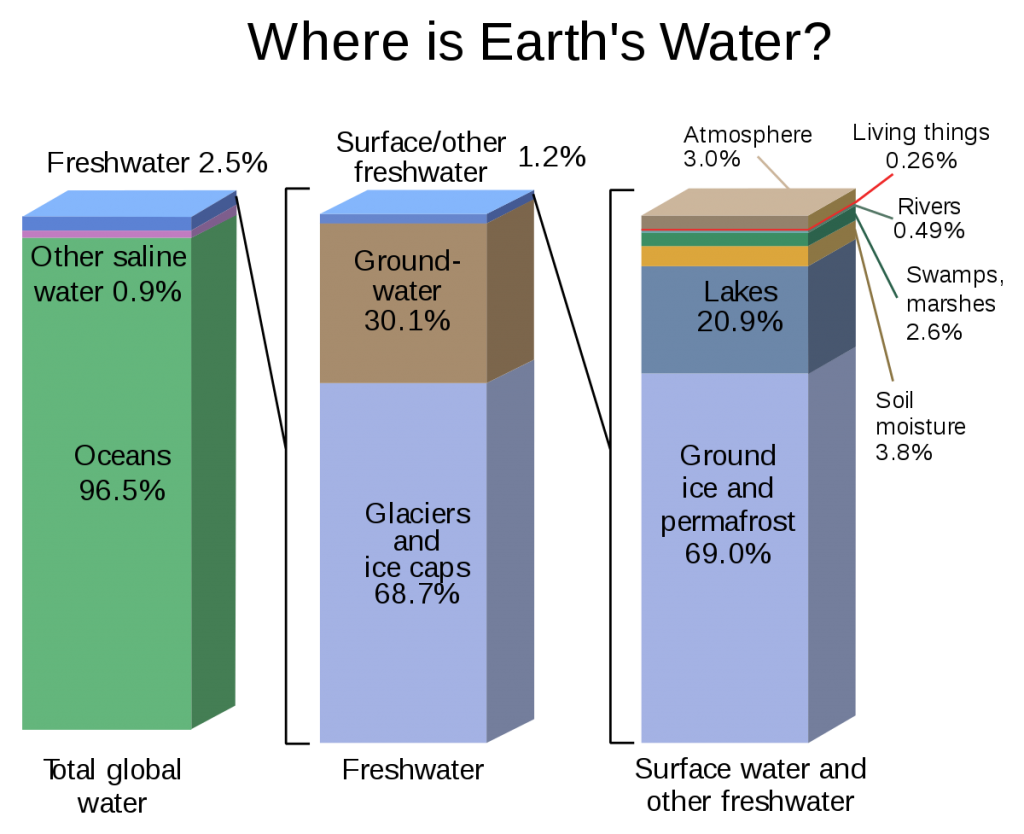Water is an essential component of all life forms that exist over the surface of the earth.
The creatures on the earth are lucky that it is a water planet, otherwise we all would have no existence.
Water is a rare commodity in our solar system. There is no water on the sun or anywhere else in the solar system.
The earth, fortunately has an abundant supply of water on its surface. Hence,
our planet is called the ‘Blue Planet’
HYDROLOGICAL CYCLE
- The hydrological cycle, is the circulation of water within the earth’s hydrosphere in different forms i.e. the liquid, solid and the gaseous phases.
- It also refers to the continuous exchange of water between the oceans, atmosphere, land surface and subsurface and the organisms
- Water is a cyclic resource. It can be used and re-used. Water also undergoes a cycle from the ocean to land and land to ocean.
- The hydrological cycle describes the movement of water on, in, and above the earth.
- The water cycle has been working for billions of years and all the life on earth depends on it.
- Next to air, water is the most important element required for the existence of life on earth.
- The distribution of water on earth is quite uneven. Many locations have plenty of water while others have very limited quantity.
Water in different forms
About 71 per cent of the planetary water is found in the oceans. The remaining is held as freshwater in glaciers and icecaps, groundwater sources, lakes, soil moisture, atmosphere, streams and within life.
Nearly 59 per cent of the water that falls on land returns to the atmosphere through evaporation from over the oceans as well as from other places. The remainder runs-off on the surface, infiltrates into the ground or a part of it becomes glacier

RELIEF OF THE OCEAN FLOOR
- The oceans are confined to the great depressions of the earth’s outer layer
- The oceans, unlike the continents, merge so naturally into one another that it is hard to demarcate them.
- The geographers have divided the oceanic part of the earth into five oceans, namely the Pacific, the Atlantic, the Indian Southern ocean and the Arctic.
- The various seas, bays, gulfs and other inlets are parts of these four large oceans
- The ‘land’ under the waters of the oceans, that is, the ocean floor exhibits complex and varied features as those observed over the land
- The floors of the oceans are rugged with the world’s largest mountain ranges, deepest trenches and the largest plains.
Divisions of the Ocean Floors
The ocean floors can be divided into four major divisions:
Continental Shelf
- The continental shelf is the extended margin of each continent occupied by relatively shallow seas and gulfs.
- It is the shallowest part of the ocean showing an average gradient of 1° or even less.
- The continental shelves are covered with variable thicknesses of sediments brought down by rivers, glaciers, wind, from the land and distributed by waves and currents.
- Massive sedimentary deposits received over a long time by the continental shelves, become the source of fossil fuels.

Continental Slope
- The continental slope connects the continental shelf and the ocean basins. It begins where the bottom of the continental shelf sharply drops off into a steep slope.
- The depth of the slope region varies between 200 and 3,000 m.
- The slope boundary indicates the end of the continents. Canyons and trenches are observed in this region.
Deep Sea Plain
Deep sea plains are gently sloping areas of the ocean basins.
These are the flattest and smoothest regions of the world vary between 3,000 and 6,000m. These plains are covered with fine-grained sediments like clay and silt.

Oceanic Deeps or Trenches
These areas are the deepest parts of the oceans. The trenches are relatively steep sided, narrow basins. They are around 3-5 km deeper than the surrounding ocean floor.
They occur at the bases of continental slopes and along island arcs and are associated with active volcanoes and strong earthquakes.
Minor Relief Features
Apart from the above mentioned major relief features of the ocean floor, some minor but significant features predominate in different parts of the oceans.
Mid-Oceanic Ridges
- A mid-oceanic ridge is composed of two chains of mountains separated by a large depression.
- The mountain ranges can have peaks as high as 2,500 m and some even reach above the ocean’s surface. Iceland, a part of the mid Atlantic Ridge, is an example.
Seamount
- It is a mountain with pointed summits, rising from the seafloor that does not reach the surface of the ocean. Seamounts are volcanic in origin.
- These can be 3,000-4,500 m tall.
- The Emperor seamount, an extension of the Hawaiian Islands in the Pacific Ocean, is a good example.
Submarine Canyons
- These are deep valleys, some comparable to the Grand Canyon of the Colorado river.
- They are sometimes found cutting across the continental shelves and slopes, often extending from the mouths of large rivers.
- The Hudson Canyon is the best known submarine canyon in the world.
Guyots
It is a flat topped seamount.
They show evidences of gradual subsidence through stages to become flat topped submerged mountains. It is estimated that more than 10,000 seamounts and guyots exist in the Pacific Ocean alone.
Atoll
These are low islands found in the tropical oceans consisting of coral reefs surrounding a central depression.
It may be a part of the sea (lagoon), or sometimes form enclosing a body of fresh, brackish, or highly saline water
TEMPERATURE OF OCEAN WATERS
This section deals with the spatial and vertical variations of temperature in various oceans.
Ocean waters get heated up by the solar energy just as land. The process of heating and cooling of the oceanic water is slower than land



